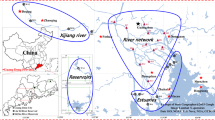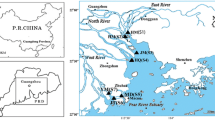Abstract
Phthalate esters are well known for their environmental contamination and toxicological effects as “endocrine disruptors.” In this study, environmental levels of phthalate esters and ecotoxicological risk assessments were performed in one of the major rivers in India, the Kaveri. Water and sediment samples were collected during 2010–2012 representing the major stretch of the river and extracted by solid-phase and ultrasonic methods, respectively, and analyzed for six major phthalates by using a gas chromatograph–mass spectrometer. The analytical recovery for phthalates in water and sediment ranged from 79 to 121 %. Results indicated that diethyl phthalate (DEP) and dimethyl phthalate were found in every sample, whereas butylbenzyl phthalate and diethylhexyl phthalate (DEHP) were detected in 92 % of the water samples. Likewise, in sediment samples, DEP was found most often (94 %). The total phthalates in water samples ranged from 313 to 1,640 ng/l, whereas in sediments it was 2 to 1,438 ng/g dw (dry weight) with DEHP having the highest concentration. Human health risk assessment based on drinking water consumption showed no potential risk for phthalates and also DEHP levels were safe with respect to USEPA guideline (6,000 ng/l). Further, DEHP and di-n-octyl phthalate levels in water were expected to pose little threat to sensitive organisms in the riverine ecosystem as per ECOSAR chronic values. In case of sediment, the DEHP concentration was well above the USEPA sediment guideline value. To our knowledge, this is the first study to describe the levels and ecotoxicological risks of phthalates in Kaveri River, India.





Similar content being viewed by others
References
Bendz, D., Paxeus, N. A., Ginn, T. R., & Loge, F. J. (2005). Occurrence and fate of pharmaceutically active compounds in the environment, a case study: Hoje River in Sweden. Journal of Hazardous Materials, 122(3), 195–204.
Berge, A., Cladiere, M., Gasperi, J., Coursimault, A., Tassin, B., & Moilleron, R. (2013). Meta-analysis of environmental contamination by phthalates. Environmental Science and Pollution Research, 20(11), 8057–8076.
CARDS (2011) Performance of agriculture in river basins of Tamil Nadu in the last three Decades—A total factor productivity approach. Centre for Agricultural and Rural Development Studies. Report prepared by K. Palanisami, C. R. Ranganathan, A. Vidhyavathi, M. Rajkumar, and N. Ajjan. http://planningcommission.nic.in/reports/sereport/ser/ser river1905.pdf. Accessed 20 December 2013.
Casals-Casas, C., & Desvergne, B. (2011). Endocrine Disruptors: From Endocrine to Metabolic Disruption. Annual Review of Physiology, 73(1), 135–162.
Chakraborty, P., & Zhang, G. (2012). Organochlorine pesticides, polychlorinated biphenyls, and polybrominated diphenyl ethers in the Indian atmosphere. In B. G. Loganathan & P. K. S. Lam (Eds.), Global contamination trends of persistent organic chemicals (pp. 179–202). Boca Raton, FL: CRC Press.
Chemsec (2013). Phthalates found in everything from toys and clothes to paints, cosmetics, and electronics.http://www.chemsec.org/what-we-do/influencing-public-policy/endocrine-disrupters/found-in-consumer-products/phthalates. Accessed 20 December 2013.
Chikae, M., Ikeda, R., Hatano, Y., Hasan, Q., Morita, Y., & Tamiya, E. (2004). Effects of bis(2-ethylhexyl) phthalate, γ-hexachlorocyclohexane, and 17β-estradiol on the fry stage of medaka (Oryziaslatipes). Environmental Toxicology and Pharmacology, 18(1), 9–12.
Colon, I., Caro, D., Bourdony, C. J., & Rosario, O. (2000). Identification of phthalate esters in the serum of young Puerto Rican girls with premature breast development. Environmental Health Perspectives, 108(9), 895–900.
CPSIA (2008). Consumer product safety improvement act of 2008. http://www.cpsc.gov/Media/Documents/Regulations-Laws-Standards/Statutes/cpsia/. Accessed 20 December 2013.
Cullen, S. (2012). Global plasticizer update. http://www.plasticsindustry.org/files/events/Stephen%20Cullen_Tuesday.pdf.
Dargnat, C., Blanchard, M., Chevreuil, M., & Teil, M. J. (2009). Occurrence of phthalate esters in the Seine River estuary (France). Hydrological Processes, 23(8), 1192–1201.
DGOS (2013) Final findings of PAN review. Directorate General of Safeguards, Customs and Central Excise, Government of India. http://www.dgsafeguards.gov.in/newversion/Final%20findings%20of%20pan%20review.pdf. Accessed 20 December 2013.
Ellington, J. J., & Floyd T. L. (1996). Octanol/water partition coefficients for eight phthalate esters. USEPA, National Exposure Research Laboratory. Report no. EPA/600/S-96/006. http://nepis.epa.gov/Exe/ZyPURL.cgi?Dockey=30003VNC.txt. Accessed 20 December 2013.
Fromme, H., Küchler, T., Otto, T., Pilz, K., Müller, J., & Wenzel, A. (2002). Occurrence of phthalates and bisphenol A and F in the environment. Water Research, 36(6), 1429–1438.
Guo, Y., Alomirah, H., Cho, H.-S., Minh, T. B., Mohd, M. A., Nakata, H., et al. (2011). Occurrence of phthalate metabolites in human urine from several Asian countries. Environmental Science and Technology, 45(7), 3138–3144.
Hadjmohammadi, M. R., Fatemi, M. H., & Taneh, T. (2011). Coacervative extraction of phthalates from water and their determination by high performance liquid chromatography. Journal of the Iranian Chemical Society, 8(1), 100–106.
Hazardous Product Act (2010). Department of Health, Canada. http://www.gazette.gc.ca/rp-pr/p1/2009/2009-06-20/html/reg3-eng.html. Accessed 20 December 2013.
He, H., Hu, G., Sun, C., Chen, S., Yang, M., Li, J., et al. (2011). Trace analysis of persistent toxic substances in the main stream of Jiangsu section of the Yangtze River, China. Environmental Science and Pollution Research, 18(4), 638–648.
Hongjun, Y., Wenjun, X., Qing, L., Jingtao, L., Hongwen, Y., & Zhaohua, L. (2013). Distribution of phthalate esters in topsoil: a case study in the Yellow River Delta, China. Environmental Monitoring and Assessment, 185(10), 8489–8500.
Hsieh, T. H., Tsai, C. F., Hsu, C. Y., Kuo, P. L., Lee, J. N., Chai, C. Y., et al. (2012). Phthalates induce proliferation and invasiveness of estrogen receptor-negative breast cancer through the AhR/HDAC6/c-Myc signaling pathway. The FASEB Journal, 26(2), 778–787.
Johnson, S., Saikia, N., & Sahu, R. (2011). Phthalates in toys available in Indian market. Bulletin of environmental contamination and toxicology, 86(6), 621–626.
Kruger, T., Long, M., & Bonefeld-Jørgensen, E. C. (2008). Plastic components affect the activation of the aryl hydrocarbon and the androgen receptor. Toxicology, 246(2–3), 112–123.
Latini, G. (2005). Monitoring phthalate exposure in humans. Clinicachimicaacta; International Journal of Clinical Chemistry, 361(1–2), 20–29.
Lopez-Carrillo, L., Hernandez-Ramirez, R. U., Calafat, A. M., Torres-Sanchez, L., Galvan-Portillo, M., Needham, L. L., et al. (2010). Exposure to phthalates and breast cancer risk in northern Mexico. Environmental Health Perspectives, 118(4), 539–544.
Mankidy, R., Wiseman, S., Ma, H., & Giesy, J. P. (2013). Biological impact of phthalates. Toxicology Letters, 217(1), 50–58.
Martine, B., Marie-Jeanne, T., Cendrine, D., Fabrice, A., & Marc, C. (2013). Assessment of adult human exposure to phthalate esters in the urban centre of Paris (France). Bulletin of Environmental Contamination and Toxicology, 90(1), 91–96.
Oehlmann, J., Schulte-Oehlmann, U., Kloas, W., Jagnytsch, O., Lutz, I., Kusk, K. O., et al. (2009). A critical analysis of the biological impacts of plasticizers on wildlife. Philosophical Transactions of the Royal Society B: Biological Sciences, 364(1526), 2047–2062.
Olujimi, O. O., Fatoki, O. S., Odendaal, J. P., & Okonkwo, J. O. (2010). Endocrine disrupting chemicals (phenol and phthalates) in the South African environment: A need for more monitoring. Water SA, 36(5), 671–682.
Peijnenburg, W. J. G. M., & Struijs, J. (2006). Occurrence of phthalate esters in the environment of the Netherlands. Ecotoxicology and Environmental Safety, 63(2), 204–215.
Petrovic, M., Eljarrat, E., Lopez de Alda, M. J., & Barcelo, D. (2001). Analysis and environmental levels of endocrine-disrupting compounds in freshwater sediments. Trends in Analytical Chemistry, 20(11), 637–648.
Ramaswamy, B. R., Shanmugam, G., Velu, G., Rengarajan, B., & Larsson, D. G. (2011). GC–MS analysis and ecotoxicological risk assessment of triclosan, carbamazepine and parabens in Indian rivers. Journal of Hazardous Materials, 186(2), 1586–1593.
Rengarajan, S., Parthasarathy, C., Anitha, M., & Balasubramanian, K. (2007). Diethylhexyl phthalate impairs insulin binding and glucose oxidation in Chang liver cells. Toxicology in Vitro, 21(1), 99–102.
Roy, S., & Kalita, J. C. (2011). Determination of endocrine disrupting compounds in water bodies around Guwahati city, Assam, India through gas chromatography/mass spectrometry. International Journal of Chemtech Research, 3(4), 1840–1844.
Sanchez-Avila, J., Tauler, R., & Lacorte, S. (2012). Organic micropollutants in coastal waters from NW Mediterranean Sea: sources distribution and potential risk. Environment International, 46, 50–62.
Santhi, V. A., & Mustafa, A. M. (2013). Assessment of organochlorine pesticides and plasticisers in the Selangor River basin and possible pollution sources. Environmental Monitoring and Assessment, 185(2), 1541–1554.
Selvaraj, K. K., Shanmugam, G., Sampath, S., Joakim Larsson, D. G., & Ramaswamy, B. R. (2014). GC–MS determination of bisphenol A and alkylphenolethoxylates in river water from India and their ecotoxicological risk assessment. Ecotoxicology and Environmental Safety, 99, 13–20.
Sha, Y., Xia, X., Yang, Z., & Huang, G. H. (2007). Distribution of PAEs in the middle and lower reaches of the Yellow River, China. Environmental Monitoring and Assessment, 124(1–3), 277–287.
Shanmugam, G., Sampath, S., Selvaraj, K. K., Larsson, D. J., & Ramaswamy, B. R. (2014). Non-steroidal anti-inflammatory drugs in Indian rivers. Environmental Science and Pollution Research, 1–11.
Solís, M. E., Liu, C. C., Nam, P., Niyogi, D. K., Bandeff, J. M., & Huang, Y.-W. (2007). Occurrence of organic chemicals in two rivers inhabited by Ozark Hellbenders (Cryptobranchus alleganiensis bishopi). Archives of Environmental Contamination and Toxicology, 53(3), 426–434.
Srivastava, A., Sharma, V. P., Tripathi, R., Kumar, R., Patel, D. K., & Mathur, P. K. (2010). Occurrence of phthalic acid esters in Gomti river sediment, India. Environmental Monitoring and Assessment, 169(1–4), 397–406.
Sung, H. H., Kao, W. Y., & Su, Y. J. (2003). Effects and toxicity of phthalate esters to hemocytes of giant freshwater prawn, Macrobrachium rosenbergii. Aquatic Toxicology, 64(1), 25–37.
Takeoka, H., Ramesh, A., Iwata, H., Tanabe, S., Subramaniam, A. N., Mohan, D., et al. (1991). Fate of insecticide HCH in the tropical coastal area of south India. Marine Pollution Bulletin, 22(6), 290–297.
Teil, M. J., Blanchard, M., Moreau-Guigon, E., Dargnat, C., Alliot, F., Bourges, C., et al. (2013). Phthalate fate in the hydrographic network of the river Seine Basin (France) under contrasted hydrological conditions. Water, Air, and Soil pollution, 224(6), 1–14.
USEPA (1989) Risk assessment guidance for superfund volume I human health evaluation manual (Part A). EPA/540/1-89/002. Office of Emergency and Remedial Response; U.S. Environmental Protection Agency Washington, DC. http://www.epa.gov/oswer/riskassessment/ragsa/pdf/rags-vol1-pta_complete.pdf. Accessed 20 December 2013.
USEPA (2006) Freshwater and marine sediment screening benchmark values. http://www.epa.gov/reg3hwmd/risk/eco/index.htm. Accessed 20 December 2013.
USEPA (2011) Ecological Structure Activity Relationships (ECOSAR) Class Program, Version 1.11. http://www.epa.gov/oppt/newchems/tools/21ecosar.htm. Accessed 12 September 2013.
USEPA (2012) Phthalates action plan. http://www.epa.gov/oppt/existingchemicals/pubs/actionplans/phthalates_actionplan_revised_2012-03-14.pdf. Accessed 20 December 2013.
USEPA (2013) Regional screening level (RSL) Summary Table. http://www.epa.gov/reg3hwmd/risk/human/rb-concentration_table/Generic_Tables/docs/master_sl_table_01run_MAY2013.pdf. Accessed 20 December 2013.
Vethaak, A. D., Lahr, J., Schrap, S. M., Belfroid, A. C., Rijs, G. B. J., Gerritsen, A., et al. (2005). An integrated assessment of estrogenic contamination and biological effects in the aquatic environment of The Netherlands. Chemosphere, 59(4), 511–524.
Wang, Y., Hu, W., Cao, Z., Fu, X., & Zhu, T. (2005). Occurrence of endocrine-disrupting compounds in reclaimed water from Tianjin, China. Analytical and Bioanalytical Chemistry, 383(5), 857–863.
Wu, B., Zhang, Y., Zhang, X., & Cheng, S. (2010). Health risk from exposure of organic pollutants through drinking water consumption in Nanjing, China. Bulletin of Environmental Contamination and Toxicology, 84(1), 46–50.
Xu, H., Shao, X., Zhang, Z., Zou, Y., Wu, X., & Yang, L. (2013). Oxidative stress and immune related gene expression following exposure to di-n-butyl phthalate and diethyl phthalate in zebrafish embryos. Ecotoxicology and Environmental Safety, 93, 39–44.
Yuan, S. Y., Liu, C., Liao, C. S., & Chang, B. V. (2002). Occurrence and microbial degradation of phthalate esters in Taiwan river sediments. Chemosphere, 49(10), 1295–1299.
Yuwatini, E., Hata, N., & Taguchi, S. (2006). Behavior of di(2-ethylhexyl) phthalate discharged from domestic waste water into aquatic environment. Journal of Environmental Monitoring, 8(1), 191–196.
Acknowledgments
The authors are grateful to the United Nations University, Tokyo, Japan and Shimadzu Corporation, Japan for the GC–MS facility established through the project “POPs Monitoring in Asian Coastal Hydrosphere” and DST, New Delhi for laboratory facilities under DST-FIST programme. One of the authors, K. K. S., is thankful to Department of Science and Technology (DST), India, for providing Junior Research Fellow under the DST-PURSE program. Likewise, the co-author S.S. would like to thank the University Grants Commission, India, for providing research fellowship.
Author information
Authors and Affiliations
Corresponding author
Electronic supplementary material
Below is the link to the electronic supplementary material.
Rights and permissions
About this article
Cite this article
Selvaraj, K.K., Sundaramoorthy, G., Ravichandran, P.K. et al. Phthalate esters in water and sediments of the Kaveri River, India: environmental levels and ecotoxicological evaluations. Environ Geochem Health 37, 83–96 (2015). https://doi.org/10.1007/s10653-014-9632-5
Received:
Accepted:
Published:
Issue Date:
DOI: https://doi.org/10.1007/s10653-014-9632-5




